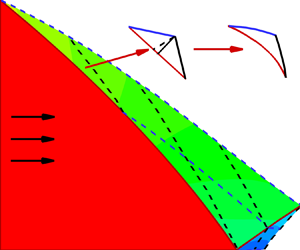Crossref Citations
This article has been cited by the following publications. This list is generated based on data provided by
Crossref.
Ji, Junze
Li, Zhufei
Zhang, Enlai
Si, Dongxian
and
Yang, Jiming
2022.
Intensification of non-uniformity in convergent near-conical hypersonic flow.
Journal of Fluid Mechanics,
Vol. 931,
Issue. ,
Zhou, Hang
Jin, Zhiguang
Zhuang, Guoxing
and
Shi, Chaogang
2022.
Space-streamline-based method of characteristics for inverse design of three-dimensional super/hypersonic flows.
Physics of Fluids,
Vol. 34,
Issue. 8,
Cheng, Jianrui
Yang, Kai
Zheng, Xiaogang
Shi, Chongguang
Zhu, Chengxiang
and
You, Yancheng
2022.
Analytical model for predicting the length scale of shock/boundary layer interaction with curvature.
Physics of Fluids,
Vol. 34,
Issue. 11,
Huang, He-xia
Tan, Hui-jun
Li, Fang-bo
Tang, Xue-bin
Qin, Yuan
Xie, Li-Bin
Xu, Yao-Yu
Li, Can-min
Gao, Si-min
Zhang, Yue
Sun, Shu
and
Zhao, Dan
2023.
A review of the shock-dominated flow in a hypersonic inlet/isolator.
Progress in Aerospace Sciences,
Vol. 143,
Issue. ,
p.
100952.
Zhang, Tao
Xu, Kejing
Shi, Chongguang
Zhu, Chengxiang
and
You, Yancheng
2023.
Reflection and transition of planar curved shock waves.
Journal of Fluid Mechanics,
Vol. 959,
Issue. ,
Xiong, Haochen
Qiu, Ruofan
Han, Xin
Yan, Hao
and
You, Yancheng
2023.
Investigating the flow characteristics and thermodynamic performance of curved detonation waves.
Physics of Fluids,
Vol. 35,
Issue. 8,
Shi, Chongguang
You, Yancheng
Zheng, Xiaogang
and
Zhu, Chengxiang
2023.
Analytical model for curved-shock Mach reflection.
Physics of Fluids,
Vol. 35,
Issue. 3,
Cheng, Jianrui
Zhang, Tao
Shi, Chongguang
Da, Xingya
Zhu, Chengxiang
and
You, Yancheng
2024.
Analytical reconstruction of axisymmetric curved shock wave/boundary layer interactions.
Physics of Fluids,
Vol. 36,
Issue. 4,
Tian, Zhong Wei
and
Cui, Kai
2024.
A study of streamline geometries in subsonic and supersonic regions of compressible flow fields.
Journal of Fluid Mechanics,
Vol. 987,
Issue. ,
Qiu, Ruofan
Yang, Xinyuan
Bao, Yue
You, Yancheng
and
Jin, Hua
2024.
Mesoscopic Kinetic Approach of Nonequilibrium Effects for Shock Waves.
Entropy,
Vol. 26,
Issue. 3,
p.
200.
Tian, Zhong Wei
2024.
A study of conical and curved shock waves via the streamline transformation method.
Physics of Fluids,
Vol. 36,
Issue. 9,
Hu, Zhancang
Li, Zhonglong
Tang, Yiqi
Yu, Yaokun
Zhang, Yuchao
Zheng, Xiaogang
Zhu, Chengxiang
and
You, Yancheng
2024.
Conceptual design methodology and performance evaluation of turbine-based combined cycle inward-turning inlet with twin-design points.
Aerospace Science and Technology,
Vol. 152,
Issue. ,
p.
109309.
Gong, Tianyu
Long, Yaosong
Cheng, Zhongtao
and
Li, Yiqing
2024.
Recent development of integrated design and improving methods of waverider and inlet.
Advances in Aerodynamics,
Vol. 6,
Issue. 1,
Yan, Hao
Shi, Chongguang
Xiong, Haochen
Han, Xin
and
You, Yancheng
2024.
Curved detonation equations with analysis and its applications.
Journal of Fluid Mechanics,
Vol. 999,
Issue. ,
ZHANG, Bo
YI, Shihe
ZHAO, Yuxin
YANG, Rui
ZHU, Ziyuan
and
ZENG, Ruitong
2025.
Space-marching inverse design of subsonic, transonic, and supersonic internal flowfields.
Chinese Journal of Aeronautics,
Vol. 38,
Issue. 2,
p.
103058.
Li, Dengke
Dai, Chunliang
Sun, Bo
and
Chen, Xiong
2025.
Method of characteristics with thermo-chemical non-equilibrium for high Mach number inlet.
Physics of Fluids,
Vol. 37,
Issue. 2,
Zhang, Tao
Rao, Luoyu
Zhang, Xuhui
Shi, Chongguang
Zhu, Chengxiang
and
You, Yancheng
2025.
Heating reduction with shock control for a V-shaped blunt leading edge.
Journal of Fluid Mechanics,
Vol. 1002,
Issue. ,
YAN, Hao
XIONG, Haochen
HAN, Xin
SHI, Chongguang
and
YOU, Yancheng
2025.
Method of characteristics for curved-detonation by inverse design.
Chinese Journal of Aeronautics,
p.
103793.



